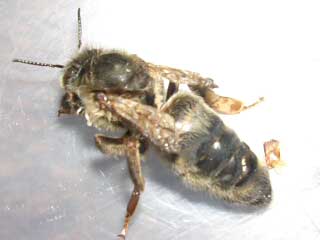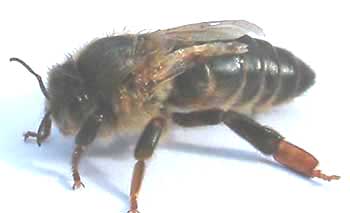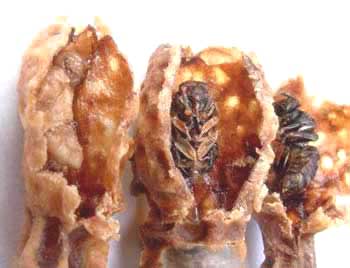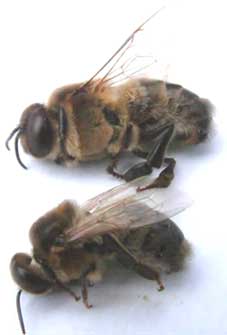QUEENS-POOR MATING AND LAYING
By Roger Patterson, GB
from
Symptoms
It does not seem to matter if the cells are swarm, emergency, or artificial. They can all result in failure, and in roughly the same proportions. When raising queens myself my preference is for the punched cell method and the “take” has still been very good. I normally have 10 cells in a cell raising colony and it has always been normal to lose one or two.
I list below all the things that I have experienced:
1. Queens emerging with deformed or stubby wings. This has now become quite common. Fig 2. shows one from a batch of 18 sealed cells that was raised in my local Assn apiary, see picture below. I believe this may be a virus similar to Deformed Wing Virus, although I have had queens like this that have been raised from colonies where the workers show no visible signs of DWV, as this one had. It is obvious these queens can’t fly and I am sure that many virgin queens that “disappear” have been sufferers and not been noticed.
|
|
|
| Fig 1 | Fig. 2 |
| 2. Queen cells with dead and decomposed larvae in them. Fig 3. shows three cells from a batch of 10 that were raised in the same colony. They are all dead and in different states. The two on the right have both coloured up, but are different sizes. |
|
|
Fig 3. |
3. Instances where a queen has obviously emerged but never starts to lay. This could be connected to 1. above
| 4. Queens getting mated, but laying a variable amount of drone eggs in worker cells. The amount can vary from the odd few to 100%. These are easy to see due to the raised cappings. Make sure they are actually worker cells though. Don’t forget it is rare for drone cells to be on their own, they are usually in patches. Fig 4 shows an example, and it is obvious that these drones are in worker cells. | 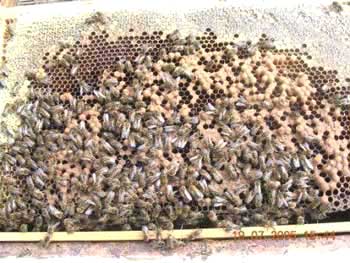 |
|
Fig 4. |
5. Patchy brood. I am not sure why this is as the cases I have seen are not always linked with something obvious such as chalk brood. The egg laying pattern is often good, suggesting that the eggs are not viable and are removed by the bees.
6. Recently mated queens laying eggs either off centre in the base of the cell or two eggs in a cell. This is not to be confused with laying workers. Often there are other problems as well such as drone brood in worker cells. Often the larvae develops off centre as well. This may be because the queens are smaller than they should be and they are unable to locate the correct part of the cell.
7. Queen cells being built soon after a queen commences to lay, in some cases in small colonies. This is sometimes in colonies where there appears to be no visible problem with the brood. I assume that for some reason there is a problem with the queen substance or the amount that the queen is producing.
8. Queens “disappearing”. This happened twice in one week in my local Assn apiary with the current seasons queens (2005), one in a colony on 4-5 frames and one with 7-8 frames. In both cases there was a problem with the brood. I also had the same in my own apiary with two colonies, one with a current seasons queen (2005), and the other with the previous seasons (2004), both with perfect brood. Both colonies had given around 60-80lb of early honey and had 4 full supers on. They had both yielded around 150lb of honey. In none of them was the timing right for a queen to be lost or killed during manipulation.
9. Young queens freely laying drone eggs only, but both sides of a brand new wire Q/E! This suggests that queens are smaller than they should be.
10. Young queens quickly turning into drone layers.
11. Some young queens laying in drone cells only.
12. Queens stopping laying. If they restart it is usually with a high percentage of drone brood, and often total drone brood.
|
14. Brood cappings that are domed more than normal worker, but less than normal drone brood. I have not investigated this much to find out what bees are produced. 15. Drones being retained much later in the season. This has previously been an indication that the bees are not happy with their queen, and it seems logical that this is the reason, but in many more instances. 16. Queens developing upside down in their cells.
|
|
|
Fig. 5 |
What should beekeepers be doing?
Management techniques will be developed, but until then can I suggest that beekeepers take the following steps:-
· Make sure that you can recognise healthy brood and know what a good pattern should be like. It is surprising how many fairly experienced beekeepers can’t! In the booklet "Foul Brood Disease of Honey Bees: Recognition and Control" published by C.S.L. there are some very good photographs of healthy brood.
· As often as possible for 12-14 days after your queen is due to emerge check around the hive for a small cluster of bees. On several occasions I have seen a virgin queen in such a cluster, and not always at the front of the hive. This should alert you to the fact that her wings are deformed and she can’t fly. See Fig 2.
· Once a queen is successfully mated and laying well it makes sense to keep her as long as possible. Any problems so far have shown soon after a queen has mated. There is little point in replacing a good queen with something else that may fail. There are strains of bees where the queens are known to be long lived and with low swarming tendencies. Perhaps we should concentrate our efforts on propagating these.
· We must assume there are parasitized drones in every area, and it would make sense to raise a large number of drones yourself. Below is a suggestion sent to me by a knowledgeable queen raiser with vast experience.
“Drone brood. One comb in every colony should give a good drone population. I suggest you place one drone comb in all your colonies. Those in the undesirable colonies should be removed when sealed, placed in the freezer to kill the drones and varroa, cleaned and reused. They should be replaced by a comb of drone brood, larvae or sealed, from a good colony. The cleaned combs could then be put in the good colonies and the process repeated. This would ensure that all drones in your apiary were from good colonies and would also give some degree of control of the varroa. Please note, bees will not accept combs of drone eggs. You may also have a problem with chalk brood in the drone combs, so perhaps better to put them in the middle of the brood nest to avoid chilling.”
My view of this is that it would have to be managed quite well otherwise varroa might be bred in the good colonies, which of course will aggravate the situation. I would suggest that each frame was coded in some way such as the use of coloured drawing pins. If used sensibly this could be combined with the IPM technique of drone culling, and in fact would be an improvement as many more drones will be retained. I think a good way of producing good drone comb would be to get them drawn out above the Q/E, then extract the honey, before putting them in the brood box. Some spares would need to be available in order to rotate them. The only problem I see is what to do with the cleaning of them. There are some beekeepers who put them outside for the birds to clean up, but I would avoid this as there is a possibility of spreading foul brood. R.P.
· I see no problems in using queen cells that are built in a colony where the queen is laying a high proportion of drones in worker cells, but you must make sure that there are no drones in the cells. This goes against the normal theories, but if there is a problem with the semen from one of the drones the queen mated with, it doesn’t mean this is the case with all of them.
· Put queen cells in cages so that they can be seen when they emerge, and the ones with deformed wings can be discarded.
· When raising queens aim for at least double the number you need.
· Try to keep basic records as you may have vital information that will help in any research. It could also help you sort out a problem.
· Alert others to the problems and ask your local Association to make members aware of them. Make sure your officials follow the suggestions set out under “Advice and suggestions for local Associations” below.
· Check the BBKA website regularly, and make sure you have the latest version of these notes.
· Take photos of any of the above problems and send them to me preferably by e-mail. If you are unable to do it yourself then please ask someone who can. Ideally I would like photographs of deformed queens, brood, and queen cells complete with the contents. Please also include the area of the country.
· If possible avoid buying colonies before the winter, otherwise they may be queenless or have a failed queen in the spring.
· I see artificial insemination playing a significant role. This could help produce a limited number of good laying queens. It could be useful in the research stages to help eliminate the possibility of such things as inbreeding.
Since I have detailed the symptoms I have experienced, I have had much correspondence from throughout the U.K. most telling me they have had unexpected problems similar to the ones I have listed, but they didn’t know the cause, and often thought it was something they were doing wrong. In the last few days I have received an e-mail from an experienced beekeeper telling me that all his 11 colonies have superseded their queens in 2005.
As a result of the BBKA website I am now beginning to get correspondence from beekeepers in other countries telling me they have experienced similar problems. It is becoming clear that it may be an international problem, and I am seeking your help in raising awareness of this issue, which is beginning to look very serious.
For more see:
http://www.bbka.org.uk/news/news/bbka/research-into-poor-queens.shtml
